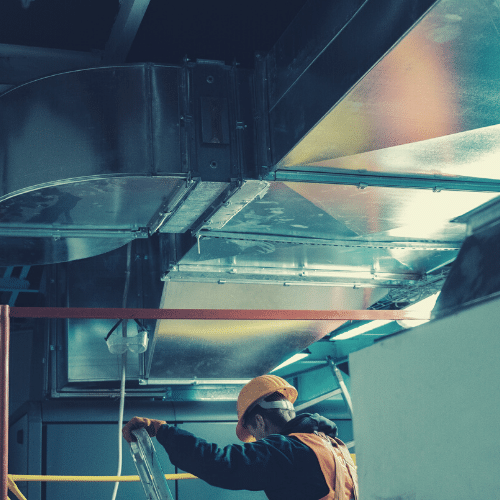- World Vision
- Serving All of SoCal
- Available 24/7
We Provide Radiant Barrier Installations for Home Owners in Southern California.
Home » HVAC Services » Radiant Barrier Services
Heating and cooling your home is about more than just having a powerful furnace or AC unit. Insulation and ventilation also play crucial roles in setting and maintaining comfortable home temperatures.
One facet of home cooling that’s easily overlooked is a radiant barrier—a thin layer, typically lining the attic, used to keep hot air out. A radiant layer is a small but crucial part of a balanced home cooling system. Without one, your living space can quickly become much hotter than it should be.
So what exactly are radiant barriers, and how do they work? To answer that, we need to look at how insulation works.
Three primary types of heat transfer occur convection, conduction, and radiation. Convection heat is the transfer of heat through liquids and gasses, such as in boiling water.

Conduction is the transfer through solid materials, like a hot pan on your stove. Most of the insulation in your home is designed to slow conduction, and convection heat flows throughout the house. This type of insulation is essential for keeping the air temperature in your home at the desired temperature year-round.
Insulation materials like fiberglass can do very little to stop the third kind of heat, radiant heat. Radiation is the transfer of heat through electromagnetic waves, such as the heat from the sun in our atmosphere. On hot summer days, the radiant heat from the sun can be overpowering to a home without a radiant barrier. Because other insulation materials don’t protect against radiant heat, an additional barrier is needed to serve that purpose.
In short, radiant barriers provide reflective insulation. Most radiant barriers are made out of a thin layer of aluminum foil insulation and another material layer for support. Without such a barrier, the sun’s heat would collect on your roof and circulate through the house. Radiant barriers work by reflecting heat out when it’s conducted through the roof into the attic space.
This attic foil reflectivity process is highly efficient and relatively simple, requiring no electricity, as it’s the result of a natural process. The combination of efficiency and low-cost materials makes a radiant barrier installation one of the most cost-effective home-cooling methods.
There are two main types of radiant barriers: perforated barriers and unperforated barriers.
Unperforated barriers aren’t advised for use in attics because they also act as vapor barriers. This traps moisture inside, leading to mildew or decay in the attic.
As the name suggests, perforated radiant barriers are perforated so that condensation doesn’t get trapped inside, making them the ideal option for attic insulation.
Radiant barriers are installed in the attic by loosely draping the aluminum layer face down against the roof. While it’s possible to do this yourself with careful attention, it’s typically best to leave the job to a professional. If not installed properly, your radiant barrier won’t reflect heat as effectively as possible.
Homeowners must consider other installation factors as well. Perhaps most importantly for those attempting a DIY installation is that the aluminum barrier will conduct electricity. Ensure that your radiant barrier doesn’t come into contact with any exposed wiring for your safety.
Proper installation is also essential to prevent dust and other particles from accumulating on your radiant barrier, and this can damage the reflective surface and diminish the barrier’s overall performance.
Most homes will be built with a radiant barrier built in. It’s typically easier to install a radiant barrier before the heat is completed, as this allows it to be “built-in” to the house’s framework. However, installing a radiant barrier in an existing attic is still possible. Whether you need to replace an old barrier or because your house was built without one, you can add a radiant barrier to an existing home.
Radiant barriers are typically installed in the attic because this is the point of the house that attracts the most direct sunlight. The barrier’s function is to reflect heat out, so it must be installed at the point receiving the most radiant heat.

Now that you know what a radiant barrier is and how it’s installed, you’re probably wondering how important they are. The importance of a radiant barrier increases along with the temperature outside, and those living in hot climates need a radiant barrier more than residents of mild climates.
For homeowners in Southern California, a radiant barrier is necessary for the summer. But why is it so important? And how does it function alongside the rest of your home’s air conditioning system?
Your home’s AC works by circulating air throughout the house until the air inside reaches the temperature on the thermostat. Any air leaking in or out of the home will interfere with the system’s ability to achieve the desired temperature. This includes radiant heat from the sun entering the home through your attic.
Without a radiant barrier, the sun’s heat can enter your attic unimpeded. The heat then gets trapped in the attic and, on hot days, can exceed temperatures exceeding 100 degrees Fahrenheit. That heat from the attic can then circulate through your house.
At the very least, circulating hot air from the attic will cause your AC to overwork itself to reach the set temperature. Over-burdening your HVAC unit is also an exorbitant waste of energy. Your cooling costs will spike significantly as your AC unit works over time due to improper ventilation. At worst, your air conditioner can overwork itself so that it begins to wear down faster. This can cause more long-term or severe problems, which will only cost more money to repair.
It’s estimated that a radiant barrier reduces solar heat in an average home’s attic by up to 40%. In warmer climates, and during warmer months, this can lead to an immense increase in energy efficiency. A radiant barrier also protects your HVAC system by saving it from unnecessary strain on hot days. This, in turn, can potentially reduce maintenance and repair costs.
Everybody deserves to be comfortable in their own home. Good, effective HVAC and insulation can help achieve that for most homeowners. If you’re in need of any home heating or cooling services, don’t hesitate to contact Home Comfort USA. Home Comfort was founded with the simple goal of helping Southern California homeowners experience the best possible comfort at home.
Home Comfort professionals can help find any solution to your heating and cooling issues. Our top priority is customer satisfaction, meaning our job’s not done if you’re not happy. We’ll work with you to find the best option for your home and your budget. Home Comfort has you covered whether you need help with AC installation or maintenance, heating, or insulation. Don’t wait for comfort—give us a call!